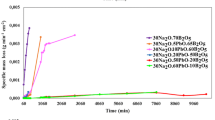Abstract
The porous compound generated from the reaction of 4-[tris(4-carboxyphenyl)methyl]benzoic acid (H4MTB) with actinide Th in simulated high-level radioactive waste can adsorb Ru, which can separate Th and Ru by more than 68.1 and 37.3%, respectively, in simulated high-level radioactive waste. The waste liquid before and after separation was vitrified with borosilicate glass and iron phosphate glass. The composition and morphology of the glasses were characterized by XRD, SEM and ICP‒OES, and the product consistency test was used to measure the chemical durability of the glasses. The chemical stability and waste loading of the glasses after the separation of actinide and noble metal elements was significantly improved. This work is of great significance for the recovery and utilization of actinide and noble metal elements in high-level radioactive waste and the optimization of the vitrification process of radioactive waste.








Similar content being viewed by others
References
Vernaz É, Bruezière J (2014) History of nuclear waste glass in France. Procedia Mater Sci 7:3–9. https://doi.org/10.1016/j.mspro.2014.10.002
Harrison MT (2014) Vitrification of high level waste in the UK. Procedia Mater Sci 7:10–15. https://doi.org/10.1016/j.mspro.2014.10.003
Ahn T, Jung H, He X, Pensado O (2008) Understanding long-term corrosion of alloy 22 container in the potential Yucca Mountain repository for high-level nuclear waste disposal. J Nucl Mater 379:33–41. https://doi.org/10.1016/j.jnucmat.2008.06.031
Keiser DD, Abraham DP, Sinkler W et al (2000) Actinide distribution in a stainless steel–15 wt% zirconium high-level nuclear waste form. J Nucl Mater 279:234–244. https://doi.org/10.1016/S0022-3115(00)00002-7
Didierlaurent R, Chauvin E, Lacombe J, et al. 2015. Cold crucible deployment in La Hague facility: the feedback from the first four years of operation-15119. In: WM2015 conference, March 15–19, 2015, Phoenix, AZ, USA
Chung C-W, Um W, Valenta MM et al (2012) Characteristics of cast stone cementitious waste form for immobilization of secondary wastes from vitrification process. J Nucl Mater 420:164–174. https://doi.org/10.1016/j.jnucmat.2011.09.021
Donald IW, Metcalfe BL, Taylor RNJ (1997) The immobilization of high level radioactive wastes using ceramics and glasses. J Mater Sci 32:5851–5887. https://doi.org/10.1023/A:1018646507438
Qian Z, Liu X, Qiao Y et al (2019) Effect of fluorine on stabilization/solidification of radioactive fluoride liquid waste in magnesium potassium phosphate cement. J Radioanal Nucl Chem 319:393–399. https://doi.org/10.1007/s10967-018-6339-6
Sugawara T, Ohira T, Komamine S, Ochi E (2015) Partitioning of rhodium and ruthenium between Pd–Rh–Ru and (Ru, Rh) O2 solid solutions in high-level radioactive waste glass. J Nucl Mater 465:590–596. https://doi.org/10.1016/j.jnucmat.2015.06.040
Eibling RE, Fowler JR (1981) Mercury reduction and removal during high-level radioactive waste processing and vitrification. MRS Online Proc Libr 6:617–622. https://doi.org/10.1557/PROC-6-617
Tong Q, Liu S, Huo J et al (2023) Structure, crystallization behavior and chemical stability analysis of Nd3+-basaltic glasses for immobilizing simulated trivalent actinides. J Nucl Mater 574:154194. https://doi.org/10.1016/j.jnucmat.2022.154194
Minichan RL Vitrification of actinide solutions in SRS separations facilities (U)
Schumacher RF, Carolina S, Ramsey WG, et al Development of a remote bushing system for actinide vitrification (U)
Zhang N, Yuan L-Y, Guo W-L et al (2017) Extending the use of highly porous and functionalized MOFs to Th(IV) capture. ACS Appl Mater Interfaces 9:25216–25224. https://doi.org/10.1021/acsami.7b04192
Xu Y, Kim S-Y, Ito T et al (2013) Chromatographic separation of platinum group metals from simulated high level liquid waste using macroporous silica-based adsorbents. J Chromatogr A 1312:37–41. https://doi.org/10.1016/j.chroma.2013.08.089
Gumber N, Pai RV, Bahadur J et al (2023) γ-Resistant microporous CAU-1 MOF for selective remediation of thorium. ACS Omega 8:12268–12282. https://doi.org/10.1021/acsomega.2c08274
Guo Y, Zhang Y, Allix M et al (2021) Rapid solidification synthesis of novel (La, Y)2(Zr, Ti)2O7 pyrochlore-based glass-ceramics for the immobilization of high-level wastes. J Eur Ceram Soc 41:7253–7260. https://doi.org/10.1016/j.jeurceramsoc.2021.07.051
Wang J (2010) High-level radioactive waste disposal in China: update 2010. J Rock Mech Geotech Eng 2(1):1–11
Yu T, Qian Z, Li L et al (2022) Synthesis of thorium dioxide nanocrystals by pyrolysis of a thorium-based metal-organic framework. ChemistrySelect. https://doi.org/10.1002/slct.202202129
Matyáš J, Gervasio V, Sannoh SE, Kruger AA (2017) Predictive modeling of crystal accumulation in high-level waste glass melters processing radioactive waste. J Nucl Mater 495:322–331. https://doi.org/10.1016/j.jnucmat.2017.08.034
Zhu H, Wang F, Liao Q, Zhu Y (2020) Synthesis and characterization of zirconolite-sodium borosilicate glass-ceramics for nuclear waste immobilization. J Nucl Mater 532:152026. https://doi.org/10.1016/j.jnucmat.2020.152026
Day DE, Wu Z, Ray CS, Hrma P (1998) Chemically durable iron phosphate glass wasteforms. J non cryst solids 241(1):1–12
Wu X, Li Z-J, Zhou H et al (2021) A microporous Ce-based MOF with the octahedron cage for highly selective adsorption towards xenon over krypton. RSC Adv 11:30918–30924. https://doi.org/10.1039/D1RA04824D
Canivet J, Fateeva A, Guo Y et al (2014) Water adsorption in MOFs: fundamentals and applications. Chem Soc Rev 43:5594–5617. https://doi.org/10.1039/C4CS00078A
Lin B, Wei K, Ni J, Lin J (2013) KOH activation of thermally modified carbon as a support of Ru catalysts for ammonia synthesis. ChemCatChem 5:1941–1947. https://doi.org/10.1002/cctc.201200889
Milonjic S (2007) A consideration of the correct calculation of thermodynamic parameters of adsorption. J Serb Chem Soc 72:1363–1367. https://doi.org/10.2298/JSC0712363M
Apel E, Deubener J, Bernard A et al (2008) Phenomena and mechanisms of crack propagation in glass-ceramics. J Mech Behav Biomed Mater 1:313–325. https://doi.org/10.1016/j.jmbbm.2007.11.005
Liu X, Qiao Y, Qian Z, Ma H (2018) Research on chemical durability of iron phosphate glass wasteforms vitrifying SrF2 and CeF3. J Nucl Mater 508:286–291. https://doi.org/10.1016/j.jnucmat.2018.05.043
Acknowledgements
This work was supported by the “Spent nuclear fuel reprocessing special project” (BG17002003).
Author information
Authors and Affiliations
Corresponding authors
Additional information
Publisher's Note
Springer Nature remains neutral with regard to jurisdictional claims in published maps and institutional affiliations.
Rights and permissions
Springer Nature or its licensor (e.g. a society or other partner) holds exclusive rights to this article under a publishing agreement with the author(s) or other rightsholder(s); author self-archiving of the accepted manuscript version of this article is solely governed by the terms of such publishing agreement and applicable law.
About this article
Cite this article
Li, L., Qian, Z., Zhang, H. et al. Pre-treatment for the separation of actinide and noble metals from high-level radioactive waste to improve the vitrification process and performance. J Radioanal Nucl Chem 332, 5035–5043 (2023). https://doi.org/10.1007/s10967-023-09204-9
Received:
Accepted:
Published:
Issue Date:
DOI: https://doi.org/10.1007/s10967-023-09204-9




